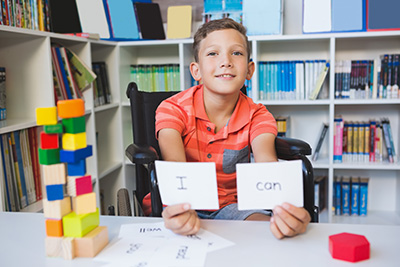How can teachers best plan for and teach students with significant cognitive disabilities in inclusive classrooms?
Page 7: Addressing Communication Needs
 People use many different methods to communicate (e.g., gestures, oral speech, written language, facial expressions). This is known as multimodal communication. Students use multimodal communication to interact with others and express themselves as they participate in learning activities. For example, a student may use gestures to wave to a classmate, use oral speech to respond to teacher questions, and use written language to text a friend.
People use many different methods to communicate (e.g., gestures, oral speech, written language, facial expressions). This is known as multimodal communication. Students use multimodal communication to interact with others and express themselves as they participate in learning activities. For example, a student may use gestures to wave to a classmate, use oral speech to respond to teacher questions, and use written language to text a friend.
multimodal communication
The different methods we use to communicate (e.g., oral speech, written speech, gestures, facial expressions, signs, etc.).
Students with significant cognitive disabilities often have complex communication needs that impact their use of some methods of communication, especially spoken language. As previously mentioned, 25-37% of students with significant cognitive disabilities do not use oral speech. Others can verbally communicate their basic needs but struggle with more complex interactions. These students often use augmentative and alternative communication (AAC)—approaches and tools that allow an individual to communicate without using oral speech. AAC serves two purposes:
augmentative and alternative communication (AAC)
One of a family of alternative methods of communication, which includes communication boards, communication books, and computerized voices; used by individuals unable to communicate readily through speech.
- Supplementing oral speech—A student who can use spoken words for simple communicative purposes may rely on AAC for more complex demands or more lengthy interactions.
- Replacing oral speech—A student who cannot engage in oral speech may exclusively use AAC to express themselves.
Did You Know?
Every behavior is an attempt at communicating something. If a student cannot effectively communicate her wants and needs, she may engage in challenging behavior. Access to AAC supports can help prevent these challenging behaviors.
AAC is multimodal and offers students with significant cognitive disabilities much flexibility and choice in communicating. Although AAC is often associated with technology, there are many different types ranging from no-tech to low-tech to high-tech. Regardless of the type, AAC supports expression, social interaction, self-worth, and safety, enabling students to more fully participate in classroom and non-classroom activities. The table below outlines examples of AAC.
|
Type |
Description |
Examples |
|
No-Tech |
Sometimes referred to as unaided communication, no-tech AAC does not require access to equipment and, therefore, is always available. |
|
|
Low-Tech |
Sometimes referred to as aided communication, low-tech AAC supports do not have an electronic component. These can be created by families and educational professionals or commercially prepared. x
communication board A form of assistive technology consisting of photographs, symbols, words/phrases, or any combination of these designed to make language visible and accessible for individuals with speech impairments. |
|
|
High-Tech |
Also referred to as aided communication, high-tech AAC devices are portable, electronic systems that provide synthetic or recorded voice output. In some systems, the user may use touch or eye gaze to select from symbols, letters, or words displayed on a screen. In other systems, the user can type text that is converted into spoken words. |
|
For Your Information
For an AAC user, his AAC is his voice. IDEA guarantees a student’s right to access his AAC for all educational activities. The student’s AAC should always be readily available and move with him throughout the school, home, and community as documented by the IEP.
A student’s necessary AAC supports are documented in the IEP. The selection of the appropriate AAC options should occur in collaboration with the student, family, and other relevant professionals (e.g., speech-language pathologists, occupational therapists). A student may use a combination of AAC supports across no-tech, low-tech, and high-tech forms, allowing them to flexibly express their intent depending on the demands of the situation.
A student who is just beginning to use AAC will require explicit instruction and modeling in how to use it effectively. All students will require ongoing support and monitoring of their AAC use. Click on each of the items below to learn how to support students’ communication in an inclusive classroom.
When a student makes any effort to communicate, the teacher should respect and recognize that attempt. The educator should label the communicative behavior and their interpretation of its meaning, even if unsure of the intended message. For example, when a student smiles, the teacher might respond, “Your smile tells me you like this story. Let’s keep reading to find out what’s next!”
Did You Know?
Communication using AAC can be more than ten times slower than speech. People who use oral speech typically generate around 135 words per minute but people using AAC may only produce 10 words per minute.
Interactions using AAC take time. For instance, when using a speech generating device, the student must process what was said, determine how to respond, locate the correct keys or icons on the device, and use them to create the message. Therefore, providing adequate wait time for a student to process the request and respond (45 seconds or more for some students) is crucial for success. By waiting, the educator signals to the student that he expects a response.
Although some students may readily use their AAC supports, others might be reluctant or need more time and practice to become comfortable with it. In any case, educators should actively promote and support all students’ use of AAC by using strategies such as reinforcement and prompting.
reinforcement
Means by which teachers can increase the probability that a behavior will reoccur in the future.
prompting
An instructional strategy in which any one of a number of different cues (e.g., gestures, illustrations or photographs, modeling) are used to help a student to learn a new skill or behavior.
Family members and educators should work together as a team to ensure a student’s access to and success with AAC. This team should collaborate to support and integrate his AAC use in all environments (e.g., home, school). For example, a teacher might provide the SLP with the vocabulary words that will be used in a lesson. The SLP can pre-teach the vocabulary words and program the AAC device so the student can participate in classroom discussions and activities.
Educators should explicitly teach the student’s peers how to recognize communication attempts and to interact appropriately. Peers can model various forms of communication, as well as the use of AAC. In addition to increasing AAC use, these interactions foster relationships, socialization, and understanding between students with significant cognitive disabilities and their classmates.
In this interview, Robert Pennington discusses how facilitating students’ ability to communicate their needs can prevent problem behavior.

Robert Pennington, PhD, BCBA-D
TIES Center, Expert Panel Member
University of North Carolina, Charlotte
Transcript: Robert Pennington
The big idea here is that many students with extensive support needs also have complex communication needs which prevent them from controlling their instructional environment. Now what I mean by controlling their instructional environment is that they’re able to ask for assistance when necessary, ask for teacher attention, or potentially even ask for a break if they need it. But when they can’t access these outcomes through conventional means they may rely on problem behavior. I would suggest maybe we start by creating environments that facilitate students asking for what they need instead of engaging in problem behavior. So maybe a general education teacher might start a year off with setting their expectations that all students should ask for what they need. She’d model appropriate asking, teach them when to ask, and then she’d remind students as they’re starting to engage in precursor behaviors that “Hey, you can ask for something instead of engage in problem behavior.” Finally, it would be really important for her to make sure, especially the students with extensive support needs, that all students have a way to communicate in order to make that request. So again, considering our students with complex communication needs, these students may touch a picture to indicate, “I need a break” or make a sign to say, “Hey, can you come over here?” Again, the whole idea is that we want to create an environment where students are self-determined, are able to advocate for their needs within the classroom. This may prevent problem behavior from occurring in the first place.
Research Shows
- According to a survey of special educators, most students with significant cognitive disabilities use one or more forms of AAC in place of or in addition to oral speech. More specifically:
- 47% use symbols
- 23% use an AAC device
- 5% use sign language
(Burnes & Clark, 2020)
- An intervention in which adults facilitated opportunities for interaction between students with significant cognitive disabilities and their peers, combined with peer modeling of AAC, increased students’ communication via spoken words, signs, and AAC.
(Biggs, Carter, Bumble, Barnes & Mazur, 2018)
Returning to the Challenge
 Ethan is a multimodal communicator who uses some spoken words, facial expressions, and body language to express his wants and needs. Additionally, Ethan is learning to use a communication board to supplement his verbal communication with a broader range of vocabulary. His educational team works collaboratively to ensure he is able to meaningfully communicate throughout the school environment. For example, the SLP creates a communication board with basic high-use words (e.g., pronouns, verbs, adjectives) and other words specific to Ethan’s interests and experiences. Ethan can use this board for most classroom activities and social interactions. Ms. O’Connor also learns how to add pages with key vocabulary specifically related to academic content. Together, the team teaches Ethan’s peers about his communication board so that they can interact with him during class activities.
Ethan is a multimodal communicator who uses some spoken words, facial expressions, and body language to express his wants and needs. Additionally, Ethan is learning to use a communication board to supplement his verbal communication with a broader range of vocabulary. His educational team works collaboratively to ensure he is able to meaningfully communicate throughout the school environment. For example, the SLP creates a communication board with basic high-use words (e.g., pronouns, verbs, adjectives) and other words specific to Ethan’s interests and experiences. Ethan can use this board for most classroom activities and social interactions. Ms. O’Connor also learns how to add pages with key vocabulary specifically related to academic content. Together, the team teaches Ethan’s peers about his communication board so that they can interact with him during class activities.

Getting to Know Students Who Use AAC This article describes how to develop student profiles, communication plans, and daily plans that can guide the successful involvement of students with complex communication needs in the inclusive classroom.
TIES 101: Communication Supports in the Inclusive Class This free asynchronous professional learning series provides evidence-based strategies for supporting AAC users in inclusive classrooms.
A Guide to Supporting Peer Interaction for Students who Use AAC This practice guide contains more information on supporting peer interaction for students who use AAC. It also includes a downloadable Peer Interaction Planning Document to observe the student who uses AAC and develop a plan to facilitate his full participation in activities with peers. |